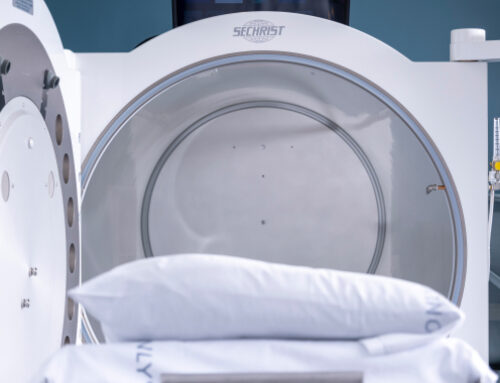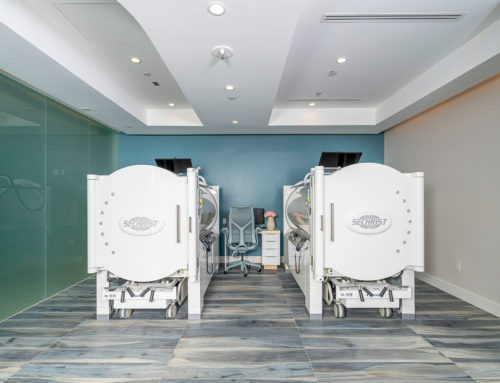1. HBOT Has Negative Side Effects
HBOT does not have many negative side effects, and the associated risks are minor. The most common side effect associated with HBOT is pressure in the ears. This pressure is similar to what you might feel when you dive to the bottom of a pool. Patients may also experience some lightheadedness or fatigue after the treatment. HBOT side effects are usually mild if the treatment length, oxygen, and air pressure are closely monitored. At Aalto Hyperbaric, our medical professionals monitor those three aspects and check patient vitals to make sure treatments are as effective as possible. Our team educates all of our patients about any potential risks associated with HBOT before beginning the treatment process.
2. HBOT Results Have Not Been Proven
There has been a lot of research done on HBOT. Researchers at the Department of Anesthesiology at Duke University Medical Center, the Department of Neurology at Louisiana State University Health Sciences Center, and many others have researched the therapy. It is a proven treatment for decompression sickness, carbon monoxide poisoning, wounds, anemia, and many more. Current research shows HBOT to be a potentially effective treatment for COVID-19. The Undersea & Hyperbaric Medical Society inspects and approves hyperbaric treatment facilities to make sure they are using the safest and most effective treatment methods.
3. HBOT Is Dangerous
HBOT is considered a safe and low-risk procedure. Our technicians are trained in providing safe hyperbaric treatment and will monitor you throughout your session. We also use HBOT chambers made by Sechrist Industries inc., a world leader in hyperbaric technology. Our chambers are FDA-approved and well-equipped to provide safe treatment.
HBOT is safe for most patients, but some should avoid getting hyperbaric treatment. If you have a collapsed lung or some types of lung disease, then HBOT may not be for you. You should also avoid HBOT if you have a cold, fever, or recent ear surgery. Wait until you have healed before coming in for treatment. Certain lifestyle choices, such as smoking or alcohol consumption, should be avoided in the weeks before and during your treatment.
Your physician can make sure you are a good candidate for treatment before writing you a prescription.
4. HBOT Is Painful
HBOT should not be painful. Sometimes the increase in pressure can cause some discomfort, but it is rare for treatment to be painful when being administered within a safe pressure level, which we follow and monitor closely. If you experience pain during your treatment, let a technician know. We can make sure that you are safe and comfortable during your session by adjusting the rate of compression, or even stopping the treatment entirely if necessary.
5. HBOT Is Only for Scuba Divers
Hyperbaric oxygen therapy was first used to treat decompression sickness in 1937. It has since become one of the main treatments for scuba divers suffering from this sickness. Decompression sickness, or “the bends,” can happen to scuba divers who come up from a dive too quickly. It happens when gases, such as nitrogen, begin to bubble in the blood. Because of this, the myth that HBOT is only used on scuba divers surfaced. While those with decompression sickness can benefit from HBOT, it is not the only condition that can be treated. The FDA has approved HBOT as a treatment for 14 different conditions, including burns, gas gangrene, and more. There are multiple other off-label conditions, which are conditions that the FDA has not approved for HBOT treatment, that can benefit from HBOT. Off-label conditions that can benefit from treatment include Alzheimer’s, depression, and autism.
6. HBOT Is Only Effective for Acute Cases
There are acute conditions, such as carbon monoxide poisoning, that can benefit from hyperbaric treatment, but they are not the only conditions that can benefit from it. Many chronic conditions, such as chronic anemia or fibromyalgia, can also benefit from using HBOT. In the case of anemia, the patient does not have enough red blood cells to carry oxygen throughout the body. HBOT introduces more oxygen into the bloodstream to help deliver oxygen to oxygen-starved tissues. HBOT can also help reduce pain in some Fibromyalgia patients by treating symptoms such as interstitial cystitis and widespread inflammation. Acute conditions may only require fewer treatments, while chronic conditions may require more sessions.
7. HBOT Is a Last Resort Treatment Option
There is a misconception that HBOT is used as a last resort when other treatment options fail. HBOT is a main treatment for decompression sickness, carbon monoxide poisoning, and sickle cell anemia. In 1955, after its success with decompression sickness in 1937, physicians began using HBOT for many other conditions. It is now used alongside other treatments for conditions including arthritis, wounds, strokes, and more.
8. HBOT Can Only Be Used To Treat Conditions Approved by the FDA
Most hospitals can only treat FDA-approved conditions with hyperbaric oxygen therapy, but freestanding hyperbaric centers such as Aalto Hyperbaric can treat off-label conditions. While lacking FDA approval, most off-label conditions have research or case studies that suggest that patients could benefit from HBOT. If you have a condition that is not FDA-approved but you feel that hyperbaric treatment could still help you, speak with your physician or reach out to Aalto Hyperbaric for more information.
9. HBOT Is Expensive
Getting HBOT does not have to be expensive. Medicare and insurance providers often cover HBOT. We can help you understand how much treatment will cost before your session if your condition is not covered by your insurance. We try to make hyperbaric oxygen therapy as cost-effective as possible, even for patients that have to pay out of pocket.
10. HBOT Does Not Require a Prescription
Hyperbaric oxygen therapy does require a prescription because the FDA recognizes 100% oxygen as a drug. If you want to make an HBOT appointment, you will need to have your physician write you a prescription before coming in for your session. We also have physicians that can write you a prescription if they feel you are a good candidate for the treatment. You can call us directly to schedule an appointment or contact us by email with any questions or concerns you might have.
Make a Hyperbaric Treatment Appointment With Aalto Hyperbaric Medical Group Today
At Aalto Hyperbaric Medical Group, we want our patients to fully understand hyperbaric treatment. Hyperbaric oxygen therapy is a safe and effective treatment that has helped improve and heal many conditions, including anemia, crush injuries, wounds, and more. Hyperbaric therapy can help treat both FDA-approved and off-label conditions. Schedule an appointment with Aalto Hyperbaric today.
RELATED POSTS
GET STARTED TODAY
Schedule an appointment with us today by calling (310) 507-7942 or using the contact form below.discover thisread what he saidelfbar 3500company website


